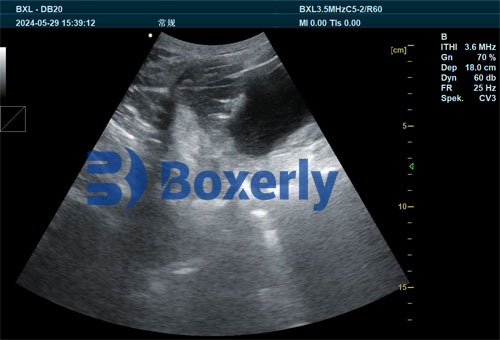As a livestock farmer, maximizing sow productivity is central to maintaining the profitability and sustainability of pig production. Among the various modern technologies available, ultrasound imaging plays a crucial role in optimizing reproduction efficiency. In our farm operations, swine ultrasound has proven especially valuable in two key areas: identifying the ideal breeding window and minimizing the occurrence of non-pregnant sows—commonly referred to as empty sows.

In this article, I’ll share my firsthand insights on how ultrasound technology contributes to improved reproductive performance and cost efficiency, focusing particularly on backfat measurement and ovarian assessments in sows.
Using Ultrasound to Determine Ideal Breeding Time
One of the most effective ways to ensure timely breeding is by monitoring sow body condition—particularly backfat thickness—through ultrasound. After weaning, sows ideally return to estrus within seven days. Those that exhibit regular estrus within this time frame often show better reproductive outcomes. However, some sows experience a longer weaning-to-estrus interval, which can indicate underlying reproductive issues.
To manage this, we use transabdominal ultrasound to evaluate the reproductive organs and backfat levels of these sows. This helps us determine whether a sow is in optimal condition for breeding. If abnormalities are detected, we initiate nutritional adjustments or veterinary interventions. Once the sow’s body condition improves, she typically resumes normal reproductive function, leading to better litter outcomes.
From a theoretical standpoint, extending the weaning-to-breeding interval can allow more time for the reproductive system to recover, potentially enhancing fertility. However, longer intervals also mean increased non-productive days, which directly reduces the number of litters per sow per year (LSY)—a key productivity metric. That’s why our approach prioritizes using ultrasound to monitor reproductive recovery while minimizing delays in breeding.
The use of ultrasound enables us to:
-
Identify and address suboptimal backfat levels
-
Evaluate uterine involution post-weaning
-
Confirm follicular development
-
Time artificial insemination with higher precision
By applying these strategies, we ensure more sows are bred within optimal windows, which boosts overall reproductive efficiency.
Reducing Non-Pregnancy with Early Detection
The gestation period of pigs typically ranges between 111–117 days, with an average of 114 days. While this may slightly vary among breeds—Yorkshire sows, for example, tend to range from 105 to 119 days, and Landrace sows from 103 to 123 days—the average remains consistent. Regardless of breed, a key challenge in sow management is identifying and preventing non-pregnancy, as every day a sow remains unproductive incurs feed, labor, and housing costs without generating returns.
On our farm, we routinely use ultrasound pregnancy diagnosis around day 25–30 after insemination. This early confirmation allows us to detect open sows and make timely rebreeding decisions, significantly reducing the time lost due to unnoticed reproductive failure.
Furthermore, ovarian ultrasound plays a critical role in improving fertility rates. By examining the sow’s ovaries, we can monitor follicular growth and detect ovulation patterns. This gives us the ability to:
-
Determine the optimal insemination window
-
Identify anestrus or cystic ovaries
-
Differentiate between true pregnancy and false positives
This level of precision not only shortens the interbreeding interval but also boosts conception rates, thereby lowering the percentage of sows culled due to reproductive failure.

Understanding the Biological Principles Behind It
The success of ultrasound relies on its ability to visualize internal structures using high-frequency sound waves, typically between 1.5 to 18 MHz. When these waves are transmitted into the sow’s body via a transducer, echoes are reflected differently depending on tissue density. The ultrasound machine converts these echoes into real-time images, allowing us to interpret the condition of soft tissues such as the uterus and ovaries.
In reproductive monitoring, B-mode (brightness mode) scanning is the most commonly used format. It provides a two-dimensional grayscale image that helps us assess the morphology of reproductive organs. In practice, we apply ultrasound gel to ensure acoustic coupling between the transducer and the animal’s skin, enabling clearer imaging.
Because the reproductive organs are located deep within the abdominal cavity, using the appropriate probe frequency is essential. Lower frequencies penetrate deeper, making them suitable for scanning large animals like sows, though with some trade-off in image resolution. In contrast, higher frequencies give better resolution but shallower penetration.
This balance is particularly important when evaluating backfat, a key indicator of sow condition. Ultrasound offers precise, non-invasive measurement of subcutaneous fat, helping us adjust feed rations and manage body condition before breeding or farrowing.
Practical Implications on the Farm
Implementing ultrasound into daily farm operations may initially require investment in equipment and training, but the return on investment (ROI) becomes evident quickly:
-
Reduced empty days: Early pregnancy diagnosis and rebreeding plans save weeks of unproductive time per sow.
-
Better litter size and uniformity: Accurate ovulation timing contributes to higher conception rates and more consistent litters.
-
Improved herd health: Detecting reproductive tract disorders early helps prevent widespread fertility issues.
-
Feed efficiency: Backfat measurements ensure feed resources are used effectively, avoiding under- or over-conditioning of breeding sows.
Moreover, as data from ultrasound evaluations accumulates, we build valuable reproductive performance records for each sow. This allows us to make informed decisions about which animals to keep in the breeding herd and which to cull, ultimately enhancing the overall productivity of the farm.
Conclusion
From my experience as a swine farmer, ultrasound technology has transformed the way we manage breeding in our herd. By enabling us to accurately determine when sows are ready to breed and quickly identify non-pregnant animals, we have significantly reduced inefficiencies and improved reproductive outcomes.
As the swine industry becomes more data-driven and performance-focused, integrating ultrasound into your reproductive management protocol isn’t just an option—it’s a necessity. With better decision-making powered by real-time imaging, we can increase profitability while maintaining animal health and welfare.